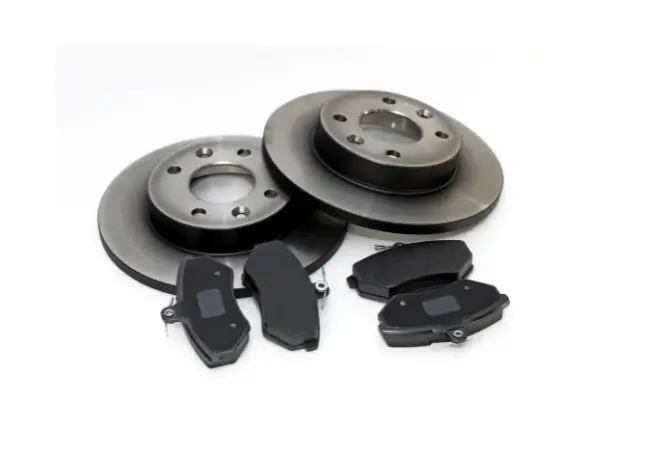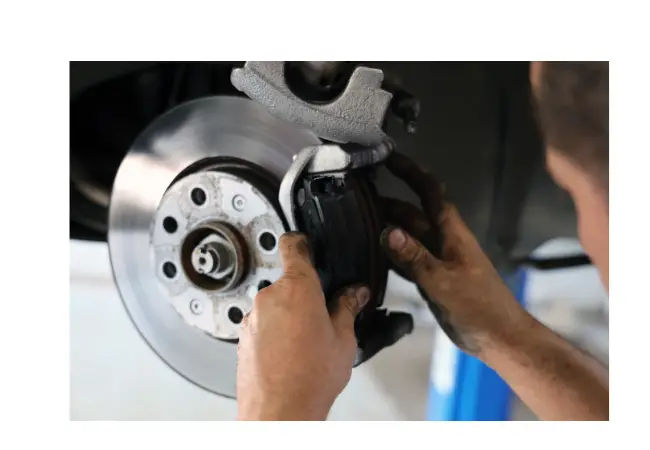Picture this: you’re driving down the highway, enjoying the open road and the freedom of the drive. Suddenly, a deer darts out in front of your car, and you’re forced to slam on the brakes. Your vehicle comes to a screeching halt, and you breathe a sigh of relief. But what if your brake pads weren’t up to the task?
Choosing the right brake pads for your vehicle is a critical component of safe driving, and with the myriad of options available, it can be a daunting task to find the right fit. In this blog post, we’ll explore the differences between a ceramic brake pad and semi-metallic brake pads, discuss their durability, and answer the question: do ceramic brake pads last longer? We will also provide helpful tips to maintain your brake pads for optimal lifespan.
Navigating the world of brake pads can be overwhelming, especially when faced with the decision between a ceramic brake pad and semi-metallic options. Both types have their own unique benefits and drawbacks, but understanding these differences is essential to making an informed decision for your vehicle.
So buckle up and join us as we dive into the comparison of ceramic and semi-metallic brake pads, and help you determine which is the best choice for your driving needs.
Contents
Short Summary
- Ceramic brake pads tend to offer increased longevity and superior durability compared to other types of brake pads.
- Semi-metallic brake pads provide better braking power but have reduced durability. Organic brakes are an economical alternative for a non-performance vehicle’s braking system.
- Regular maintenance, inspections, bedding in process, and replacing fluid can help maximize the performance & lifespan of your brakes.
Ceramic Brake Pads: The Longevity Factor

Ceramic pads are known for their impressive durability, thanks to their unique composition of ceramic compounds and other materials, such as fine copper wires. This combination results in a longer lifespan compared to organic and semi-metallic brake pads, how ceramic brake pads work makes them an attractive option for many drivers over organic pads.
However, it’s important to consider factors like driving style, environment, and maintenance, ceramic brake pads cost, all of which can affect the lifespan of your ceramic brake pads.
Ceramic Composition and Durability
To understand the durability of ceramic brake pads, we must first familiarize ourselves with their composition. Unlike the fragile ceramics used in plates and pottery, ceramic brake pads are composed of a more resilient and denser form of ceramic that is typically reinforced with fine copper fibers. This combination results in a brake pad that can withstand the constant friction and heat generated during braking.
One crucial aspect of ceramic brake pad durability is the presence of pad transfer material on the brake rotors’ surface. When new brake pads are installed, the bedding-in process deposits a layer of pad material onto the rotor, creating a more satisfactory grip and promoting even wear. Properly bedding in your brake pads is essential in preventing uneven rotor friction surfaces, which can lead to pulsation and reduced braking effectiveness.
The recommended speed for the bedding-in process is 50 MPH.
Factors Affecting the Lifespan of Ceramic Brake Pads
While ceramic brake pads are known for their durability, there are several factors that can influence their lifespan. Driving habits, such as aggressive braking, can cause the brake pads to wear out at a faster rate. Additionally, environmental factors like temperature, humidity, and road conditions can also play a role in the longevity of ceramic brake pads.
By being mindful of these factors and maintaining your brake pads properly, you can ensure optimal performance and a longer lifespan for your ceramic brake pads.
Semi-Metallic Brake Pads: A Comparison
As an alternative to ceramic brake pads, semi-metallic brake pads offer a unique set of benefits and drawbacks. Composed of a blend of metals and other materials, semi-metallic brake pads provide superior braking performance, especially in high-performance vehicles.
However, this performance advantage comes at the cost of reduced durability, making them a less ideal choice for those seeking long-lasting brake pads.
Semi-Metallic Composition and Durability
Semi-metallic brake pads are made with a blend of metals, typically consisting of 30% to 70% steel, iron, copper, and other alloys, along with fillers and a graphite lubricant. The metallic composition of these brake pads allows them to tolerate high temperatures and resist wear and tear, making them a durable option for many drivers.
Despite their durability, semi-metallic brake pads have some drawbacks. They tend to be louder than ceramic or organic brake pads, produce more brake dust and can put additional strain on the braking system. This strain can result in increased wear on other brake components, potentially leading to more frequent repairs and replacements.
Performance Differences Between Ceramic and Semi-Metallic Brake Pads
When comparing the performance of ceramic pads and semi-metallic brake pads, there are distinct differences to consider. Semi-metallic brake pads offer superior braking and stopping power when compared to ceramic brake pads, thanks to their higher metal content and enhanced heat resistance. This heat resistance allows metallic brake pads to withstand high temperatures, helping the braking system cool down more quickly and requiring less pressure on the brake pedal for effective stopping.
On the other hand, ceramic brake pads boast improved durability but sacrifice some braking power in comparison to semi-metallic brake pads. This trade-off makes ceramic brake pads a popular choice for everyday driving, while semi-metallic brake pads are often preferred for high-performance vehicles and more demanding driving conditions.
Organic Brake Pads: Another Alternative
Organic brake pads offer a third option for drivers seeking an alternative to ceramic and semi-metallic brake pads. Made of a mix of materials like rubber, carbon, glass/fiberglass, and resin, an organic brake pad is suitable for non-performance vehicles.
While they are typically cheaper than ceramic and semi-metallic brake pads, they wear out more quickly and may not be the best choice for drivers seeking long-lasting performance.
Maintaining Your Brake Pads for Optimal Lifespan

To get the most out of your brake pads, regardless of their type, it’s important to prioritize regular maintenance. This includes regular inspections, adhering to the proper bedding-in process, and replacing brake fluid as necessary.
By taking proper care of your brake pads, you can ensure performance brake pads have their optimal performance and lifespan. in your disc brake system.
Regular Inspections
It’s crucial to inspect the brake pads on your disc brakes regularly to ensure they’re in good condition and not wearing out prematurely. The recommended inspection frequency varies depending on your brake pad type and driving conditions, but as a general rule, you should inspect your brake pads every six months or each time you rotate your tires, whichever comes first.
Additionally, it’s a good idea to have your brake pad materials inspected after reaching a mileage of 30,000.
Proper Bedding-In Process
The bedding-in process is an essential aspect of brake pad maintenance, as it helps ensure that your brake pads and rotors establish a proper connection for optimal braking performance. The process involves cycling the brakes through a series of heating and cooling cycles to deposit a layer of pad material on the rotor surface.
This can be achieved by following a series of medium stops from 45mph, followed by forceful decelerations from 60mph down to 15mph, and allowing the brake pads and rotors to cool off afterward.
Replacing Brake Fluid
Replacing brake fluid is another key aspect of brake pad maintenance. Over time, brake fluid can become contaminated with moisture, which can lead to corrosion in the hydraulic system and other related issues. To prevent this, it’s important to replace your brake fluid every 12 to 36 months, depending on your vehicle’s specific needs.
By maintaining clean brake fluid, you can help keep your braking system functioning properly and ensure the longevity of your brake pads.
Choosing the Right Brake Pads for Your Vehicle
With the knowledge of the differences between ceramic, semi-metallic, and organic brake pads, you can now make an informed decision on the best type of brake pad for your vehicle. Factors such as your driving style, the environmental conditions you drive in, and your budget all play a role in determining the best brake pad option for you.
For urban commuting and everyday driving, ceramic brake pads may be the ideal choice due to their durability and reduced brake dust production. If you have a high-performance vehicle or frequently drive in demanding conditions, semi-metallic brake pads may be better suited for your needs, offering superior braking power and heat resistance.
And for those on a tight budget, organic brake pads offer a cost-effective solution but may require more frequent replacements. Ultimately, the best brake pads for your vehicle will depend on your unique driving needs and preferences.
Summary
In conclusion, the choice between organic and ceramic pads and semi-metallic brake pads depends on various factors such as driving style, environment, and budget. Ceramic brake pads offer long-lasting performance and are well-suited for everyday driving, while semi-metallic brake pads provide better braking power but sacrifice some durability, making them ideal for high-performance vehicles and demanding driving conditions. Organic brake pads are a more budget-friendly option but wear out more quickly, making them a less optimal choice for drivers seeking longevity.
By understanding the differences between these brake pad types, prioritizing regular maintenance, and carefully considering your driving habits and environment, you can make an informed decision on the best brake pads for your vehicle. With the right brake pads in place, you can hit the road with confidence knowing that your vehicle is equipped to handle whatever challenges may lie ahead.
Frequently Asked Questions
How much longer do ceramic brake pads last?
Ceramic brake pads typically last much longer than other types of brake pads, ranging from 30,000 to 70,000 miles of driving.
Providing drivers with dependable performance over time, ceramic brake pads generally have a lifespan of 30,000 to 70,000 miles – significantly longer than other types of brake pads.
What is one of the negatives of using ceramic brake pads?
The main downside of ceramic brake pads is their cost, which is significantly higher than other friction materials. They also tend to have less bite than semi-metallic brake pads and are not suitable for extremely cold climates due to reduced heat absorbency.
This can lead to possible higher temperatures in your entire braking system.
Which type of brake pad lasts the longest?
Ceramic brake pads are known for lasting the longest due to their hard composition and resistance to heat. This makes them less abrasive on a vehicle’s front brake rotors themselves, allowing them to last far longer than organic or semi-metallic brake pads.
Therefore, ceramic friction material brake pads are the most suitable choice for extended-time to replace brake pads.
